(新)高中英语倒装句(完整版详细讲义随堂练习)
- 格式:doc
- 大小:57.00 KB
- 文档页数:6
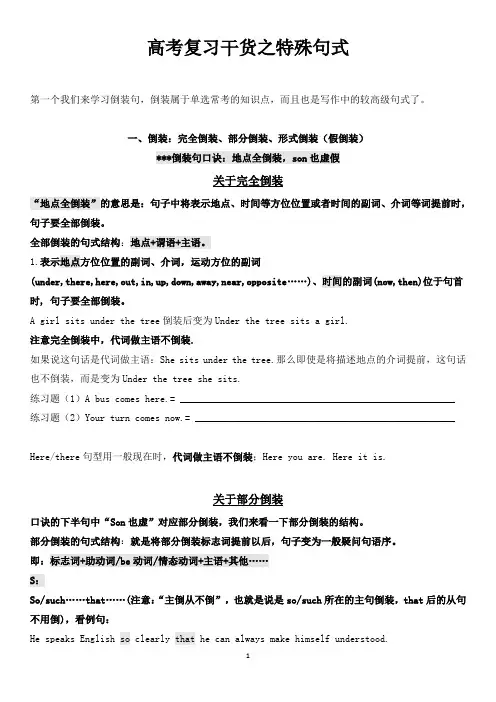
第一个我们来学习倒装句,倒装属于单选常考的知识点,而且也是写作中的较高级句式了。
一、倒装:完全倒装、部分倒装、形式倒装(假倒装)***倒装句口诀:地点全倒装,son也虚假关于完全倒装“地点全倒装”的意思是:句子中将表示地点、时间等方位位置或者时间的副词、介词等词提前时,句子要全部倒装。
全部倒装的句式结构:地点+谓语+主语。
1.表示地点方位位置的副词、介词,运动方位的副词(under,there,here,out,in,up,down,away,near,opposite……)、时间的副词(now,then)位于句首时, 句子要全部倒装。
A girl sits under the tree倒装后变为Under the tree sits a girl.注意完全倒装中,代词做主语不倒装.如果说这句话是代词做主语:She sits under the tree.那么即使是将描述地点的介词提前,这句话也不倒装,而是变为Under the tree she sits.练习题(1)A bus comes here.= _______________________________________________________ 练习题(2)Your turn comes now.= ____________________________________________________Here/there句型用一般现在时,代词做主语不倒装;Here you are. Here it is.关于部分倒装口诀的下半句中“S on也虚”对应部分倒装,我们来看一下部分倒装的结构。
部分倒装的句式结构:就是将部分倒装标志词提前以后,句子变为一般疑问句语序。
即:标志词+助动词/be动词/情态动词+主语+其他……S:So/such……that……(注意:“主倒从不倒”,也就是说是so/such所在的主句倒装,that后的从句不用倒),看例句:He speaks English so clearly that he can always make himself understood.=so是标志词,所以so clearly这个意群提前(举个例子来说意群:一辆出租车来了=来了一辆出租车,其中“一辆出租车”这几个字不能拆分,它就是一个意群),然后再将主句调整为上边说的部分倒装句式结构。
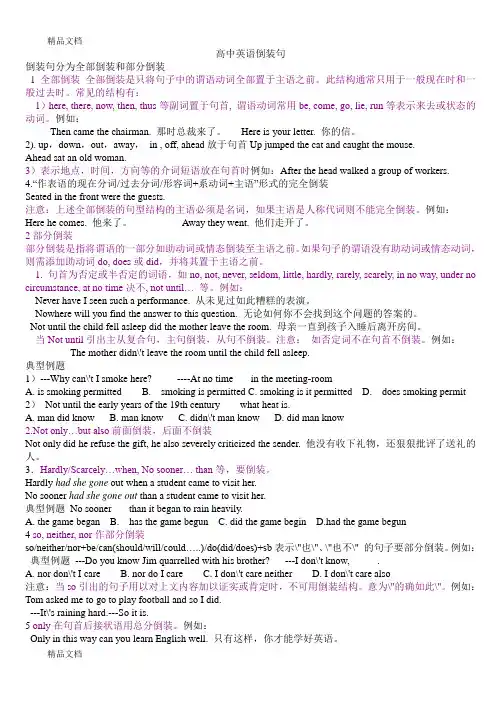
高中英语倒装句倒装句分为全部倒装和部分倒装1全部倒装全部倒装是只将句子中的谓语动词全部置于主语之前。
此结构通常只用于一般现在时和一般过去时。
常见的结构有:1)here, there, now, then, thus等副词置于句首, 谓语动词常用be, come, go, lie, run等表示来去或状态的动词。
例如:Then came the chairman. 那时总裁来了。
Here is your letter. 你的信。
2). up,down,out,away,in , off, ahead放于句首Up jumped the cat and caught the mouse.Ahead sat an old woman.3)表示地点,时间,方向等的介词短语放在句首时例如:After the head walked a group of workers.4.“作表语的现在分词/过去分词/形容词+系动词+主语”形式的完全倒装Seated in the front were the guests.注意:上述全部倒装的句型结构的主语必须是名词,如果主语是人称代词则不能完全倒装。
例如:Here he comes. 他来了。
Away they went. 他们走开了。
2部分倒装部分倒装是指将谓语的一部分如助动词或情态倒装至主语之前。
如果句子的谓语没有助动词或情态动词,则需添加助动词do, does或did,并将其置于主语之前。
1. 句首为否定或半否定的词语,如no, not, never, seldom, little, hardly, rarely, scarely, in no way, under no circumstance, at no time决不, not until… 等。
例如:Never have I seen such a performance. 从未见过如此糟糕的表演。
Nowhere will you find the answer to this question. 无论如何你不会找到这个问题的答案的。
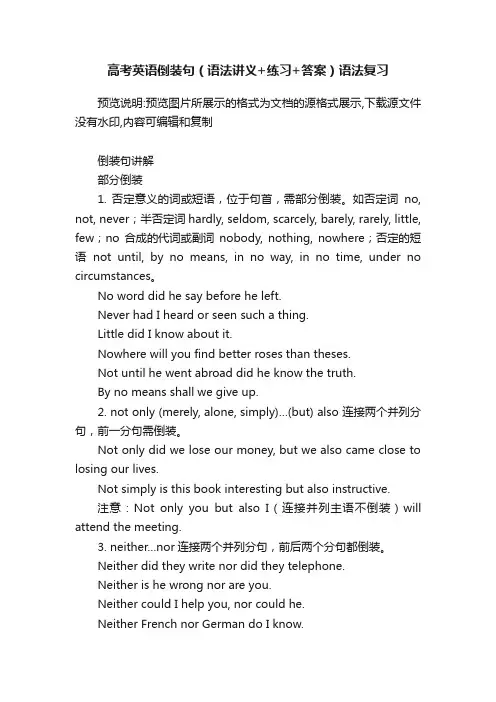
高考英语倒装句(语法讲义+练习+答案)语法复习预览说明:预览图片所展示的格式为文档的源格式展示,下载源文件没有水印,内容可编辑和复制倒装句讲解部分倒装1. 否定意义的词或短语,位于句首,需部分倒装。
如否定词no, not, never;半否定词hardly, seldom, scarcely, barely, rarely, little, few;no合成的代词或副词nobody, nothing, nowhere;否定的短语not until, by no means, in no way, in no time, under no circumstances。
No word did he say before he left.Never had I heard or seen such a thing.Little did I know about it.Nowhere will you find better roses than theses.Not until he went abroad did he know the truth.By no means shall we give up.2. not only (merely, alone, simply)…(but) also 连接两个并列分句,前一分句需倒装。
Not only did we lose our money, but we also came close to losing our lives.Not simply is this book interesting but also instructive.注意:Not only you but also I(连接并列主语不倒装)will attend the meeting.3. neither…nor连接两个并列分句,前后两个分句都倒装。
Neither did they write nor did they telephone.Neither is he wrong nor are you.Neither could I help you, nor could he.Neither French nor German do I know.Neither on Saturday nor on Sunday do we have lessons.注意: Neither you nor I(连接并列主语不倒装) like this book.4. Only + 状语,位于句首,需部分倒装。
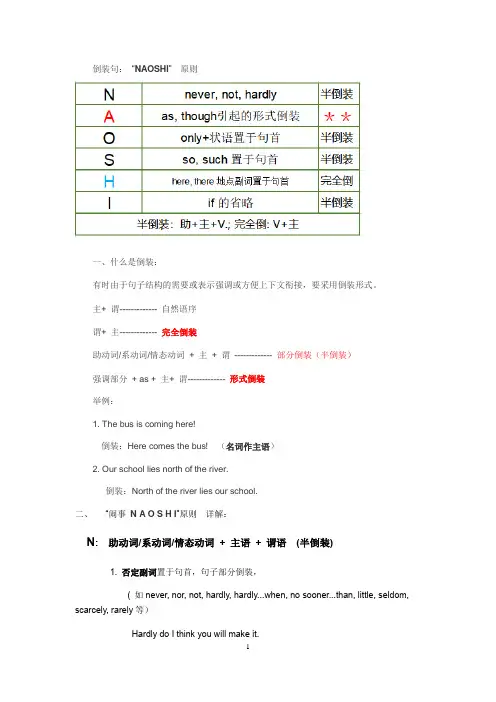
倒装句:“NAOSHI” 原则一、什么是倒装:有时由于句子结构的需要或表示强调或方便上下文衔接,要采用倒装形式。
主+ 谓------------- 自然语序谓+ 主------------- 完全倒装助动词/系动词/情态动词+ 主+ 谓------------- 部分倒装(半倒装)强调部分+ as + 主+ 谓------------- 形式倒装举例:1. The bus is coming here!倒装:Here comes the bus! (名词作主语)2. Our school lies north of the river.倒装:North of the river lies our school.二、“闹事N A O S H I”原则详解:N: 助动词/系动词/情态动词+ 主语+ 谓语(半倒装)1. 否定副词置于句首,句子部分倒装,( 如never, nor, not, hardly, hardly...when, no sooner...than, little, seldom, scarcely, rarely等)Hardly do I think you will make it.Not until midnight did it stop raining.Not only should we not be afraid of difficulties, but we should try our best to overcome them.2. 表示否定意义的短语置于句首,部分倒装,( 如at no time, under/in no circumstances, in no case, by no means,on no condition 等)By no means should you tell him about it. 你绝不要告诉他这事。
A : 形式倒装(前置)As/though引导的让步状语从句:只把强调的内容提到句首,主谓不用变化。
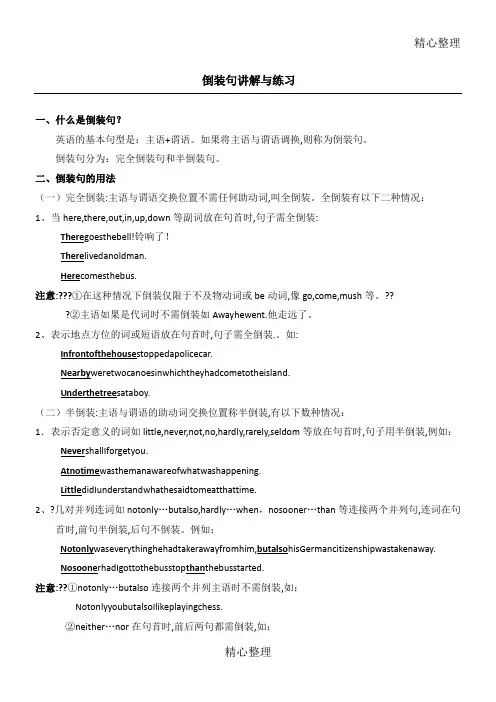
精心整理倒装句讲解与练习一、什么是倒装句?英语的基本句型是:主语+谓语。
如果将主语与谓语调换,则称为倒装句。
倒装句分为:完全倒装句和半倒装句。
二、倒装句的用法1注意212、?时,前句半倒装,后句不倒装。
例如:Notonly waseverythinghehadtakerawayfromhim,butalso hisGermancitizenshipwastakenaway.Nosoone rhadIgottothebusstop than thebusstarted.注意:??①notonly…butalso连接两个并列主语时不需倒装,如:NotonlyyoubutalsoIlikeplayingchess.②neither…nor在句首时,前后两句都需倒装,如:Neither doIhaveasister nor doesmyhusband.3、only放在句首强调状语时,主句用半倒装。
例如:Onlythen didIrealizethatIwaswrong.Onlyinthisway canIlearnfrommyfault.Onlywhenthewarwasoverin1918washeabletogetbacktowork.注意:only强调主语不倒装:如Onlytheteacherscanusetheroom.4、so…that句型,so放在句首时,主句用倒装结构,that从句不用倒装。
例如:5.倒装句练习题1.HismotherhadtalkedtohimformanyminuteswhilehewaswatchingTV,but____.A.alittledidhehear??B.littledidhehear??C.littleheardhe??D.alittleheardhe2.——Hello,ZhuHua.I’llhavetoreturntoCanadabecauseI’veworkedhereforayear. ——_____!A.Whattimeflies??B.Howtimeflies??C.Whatdoestimefly??D.Howdoestimefly3.Duringthewar,____butalsohelosthiswifeandhischild.4.6.10.——Whatsportdoyoulikebest?——Springboarddiving(跳板跳水).___todiveintowaterfromhighboard!A.Whatafunisit??B.Howfunitis??C.Howafunisit??D.Whatfunitis11.——Theoldmanwouldn’tstayathomeforarestevenifitrained.——____.Hewouldfeelsickifhestayedhomeforoneday.A.Sowouldmygrandpa???B.Sowouldn’tmygrandpaC.Neitherwouldmygrandpa??????D.Norwouldn’tmygrandpa12.___forustosurf(冲浪)ontheseainsummer!A.Whatexcitingisit??B.Howexcitingisit?C.Whatexcitingitis??D.Howexcitingitis13.Bynomeans___toourplanforthetrip.A.willsheagree??B.shewillagree??C.agreesshe??D.willagreeshe14.Thechildtiptoed(翘起脚尖走)quietlytothebird.___intotheforestwhenhewasabouttocatchit.A.Flewitaway??B.Awayflewit??C.Awayitflew??D.Flewawayit16.18.21.A.liesaverydeepvalley??B.doesaverydeepvalleylieC.averydeepvalleylies??D.averydeepvalleylays23.Theywentintoasmallhousebut___.A.nopersonsdidtheyfind????????B.notapersonfoundtheyC.notapersondidtheyfind???????D.notapersontheyfound24.——Mymotherdoesalotofhouseworkbeforegoingtowork,butshehasneverbeenlate.——_____.A.Sodoesmymother?B.Neitherdoesmymother?C.Norhasmymother?D.Soitiswithmymother25.Everyonehasarrivedateightand____.A.thendoesthemeetingbegin??B.thenbeginsthemeetingC.beginsthemeetingthen???????D.doesthemeetingbeginthen26.__itisforustoseethathedoeshisworksowell!28.30.33.MothertoldRosetobuysomesugarinthesupermarketand___.A.shedidso????B.soshedid??????C.sodidshe???????D.shedidsuch34.___shortlyafteritstoppedraining.A.Thereappearedacolorfulrainbowinthesky?B.IntheskydidacolorfulrainbowappearC.Thereacolorfulrainbowappearedinthesky?D.Thereintheskyacolorfulrainbowappeared35.Afterthepatientswentintotheoffice,__working.A.onlyadoctordidtheysee???B.onlyadoctorsawtheyC.onlyadoctortheysaw???????D.onlyadoctorhadtheyseen36.Wehavelookedforthelostsheepalmosteverywhere,butnowhere_____.A.wecanfindit???B.canwefindit???C.canfindweit???D.wecanitfind37.Onlysincetheygaveupthatgoodchance___toshowtheirinventionagain.39.40.A.sodoI????B.sowillI???C.nordoI???D.norwillI44.Sinceeveryonehascomebackhere,___.A.ongoesourdiscussion?????B.goesonourdiscussionC.ondoesourdiscussiongo??D.doesonourdiscussiongo45.__whenwepassedbyitsnest.A.Upintotheblueskydidthebirdfly?????B.UpintotheblueskythebirdflewC.Upintotheblueskyflewthebird????????D.Flewupintotheblueskythebird参考答案及讲解1.B。
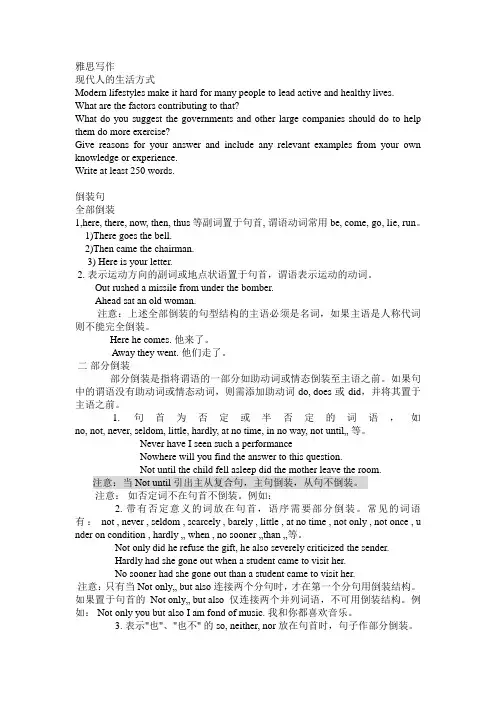
雅思写作现代人的生活方式Modern lifestyles make it hard for many people to lead active and healthy lives.What are the factors contributing to that?What do you suggest the governments and other large companies should do to help them do more exercise?Give reasons for your answer and include any relevant examples from your own knowledge or experience.Write at least 250 words.倒装句全部倒装1,here, there, now, then, thus等副词置于句首, 谓语动词常用be, come, go, lie, run。
1)There goes the bell.2)Then came the chairman.3) Here is your letter.2. 表示运动方向的副词或地点状语置于句首,谓语表示运动的动词。
Out rushed a missile from under the bomber.Ahead sat an old woman.注意:上述全部倒装的句型结构的主语必须是名词,如果主语是人称代词则不能完全倒装。
Here he comes. 他来了。
Away they went. 他们走了。
二部分倒装部分倒装是指将谓语的一部分如助动词或情态倒装至主语之前。
如果句中的谓语没有助动词或情态动词,则需添加助动词do, does或did,并将其置于主语之前。
1. 句首为否定或半否定的词语,如no, not, never, seldom, little, hardly, at no time, in no way, not until…等。
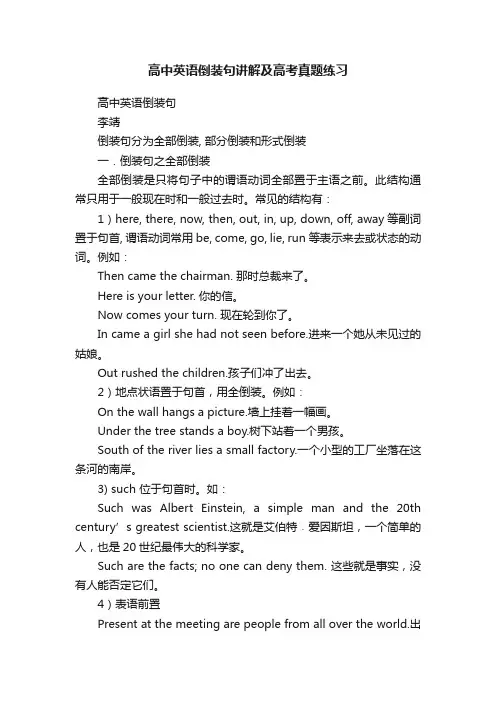
高中英语倒装句讲解及高考真题练习高中英语倒装句李靖倒装句分为全部倒装, 部分倒装和形式倒装一.倒装句之全部倒装全部倒装是只将句子中的谓语动词全部置于主语之前。
此结构通常只用于一般现在时和一般过去时。
常见的结构有:1)here, there, now, then, out, in, up, down, off, away等副词置于句首, 谓语动词常用be, come, go, lie, run等表示来去或状态的动词。
例如:Then came the chairman. 那时总裁来了。
Here is your letter. 你的信。
Now comes your turn. 现在轮到你了。
In came a girl she had not seen before.进来一个她从未见过的姑娘。
Out rushed the children.孩子们冲了出去。
2)地点状语置于句首,用全倒装。
例如:On the wall hangs a picture.墙上挂着一幅画。
Under the tree stands a boy.树下站着一个男孩。
South of the river lies a small factory.一个小型的工厂坐落在这条河的南岸。
3) such 位于句首时。
如:Such was Albert Einstein, a simple man and the 20th century’s greatest scientist.这就是艾伯特﹒爱因斯坦,一个简单的人,也是20世纪最伟大的科学家。
Such are the facts; no one can deny them. 这些就是事实,没有人能否定它们。
4)表语前置Present at the meeting are people from all over the world.出席会议的是来自于全世界的人。
注意:上述全部倒装的句型结构的主语必须是名词,如果主语是人称代词则不能完全倒装。
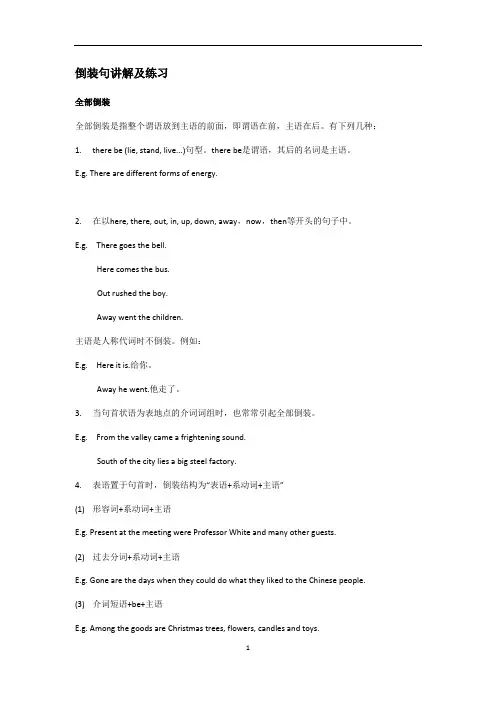
倒装句讲解及练习全部倒装全部倒装是指整个谓语放到主语的前面,即谓语在前,主语在后。
有下列几种:1.there be (lie, stand, live...)句型。
there be是谓语,其后的名词是主语。
E.g. There are different forms of energy.2.在以here, there, out, in, up, down, away,now,then等开头的句子中。
E.g. There goes the bell.Here comes the bus.Out rushed the boy.Away went the children.主语是人称代词时不倒装。
例如:E.g. Here it is.给你。
Away he went.他走了。
3.当句首状语为表地点的介词词组时,也常常引起全部倒装。
E.g. From the valley came a frightening sound.South of the city lies a big steel factory.4.表语置于句首时,倒装结构为“表语+系动词+主语”(1)形容词+系动词+主语E.g. Present at the meeting were Professor White and many other guests.(2)过去分词+系动词+主语E.g. Gone are the days when they could do what they liked to the Chinese people.(3)介词短语+be+主语E.g. Among the goods are Christmas trees, flowers, candles and toys.5.such置于句首时E.g. Such was Albert Einstein, a simple man and the 20th century’s greatest scientist.此句型中的such多被认为是表语,所以such后面的be动词应该与其后的“真正主语”保持一致。

Grammar of the Inversion (Module 5 Unit 4)倒装句英语最基本的语序是主语在前, 谓语动词在后。
但有时由于句子结构的需要或表示强调, 就要采用倒装形式。
倒装分两种情况: 1)将谓语动词完全移到主语之前称为完全倒装, 2)只将助动词或情态动词放到主语之前称为部分倒装。
并且强调性倒装和以so, neither, nor开头的句子是高考例题的热点。
一、倒装句的意义1.用倒装构成疑问句,适应一定的语法结构的需要。
.in?Was the People's Liberation Army founded in 1927?2.为了强调某一部分, 而把这部分放到句首, 构成倒装。
t.fo.schoo.thi.term.So early did he come to school that no other students came.二、倒装的用法完全倒装1.在“ther.be”结构里, there是引导词, 主语在be后。
在“there + be”结构中的谓语动词有时不用be , 而用表示类似“存在”观念的其他不及物动词。
如: live, stand, come, lie, flow, enter, rise 和appear等。
e.g.Ther.i..bo.o.th.table.There came shouts for help from the river.There lies a large wheat field in front of the house.Many years ago there lived an old man in the wooden house.2.为了表达生动, 有时把表地点、方位的副词, 如here, there, now , then,, thus ,up, down, out, off, over, away, in等放在句首, 同时把谓语动词放在主语之前, 在here, there等副词开头的某些句子里(要用一般现在时态)。
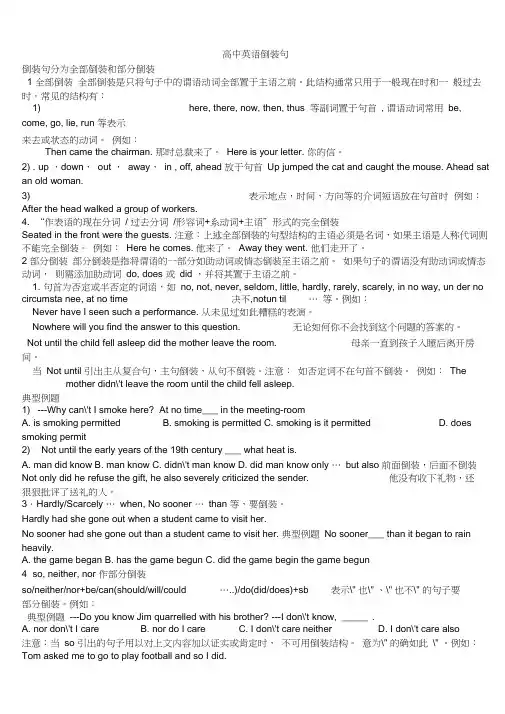
高中英语倒装句倒装句分为全部倒装和部分倒装1 全部倒装全部倒装是只将句子中的谓语动词全部置于主语之前。
此结构通常只用于一般现在时和一般过去时。
常见的结构有:1) here, there, now, then, thus 等副词置于句首, 谓语动词常用be, come, go, lie, run 等表示来去或状态的动词。
例如:Then came the chairman. 那时总裁来了。
Here is your letter. 你的信。
2) . up ,down,out ,away,in , off, ahead 放于句首Up jumped the cat and caught the mouse. Ahead sat an old woman.3) 表示地点,时间,方向等的介词短语放在句首时例如:After the head walked a group of workers.4. “作表语的现在分词/ 过去分词/形容词+系动词+主语”形式的完全倒装Seated in the front were the guests. 注意:上述全部倒装的句型结构的主语必须是名词,如果主语是人称代词则不能完全倒装。
例如:Here he comes. 他来了。
Away they went. 他们走开了。
2 部分倒装部分倒装是指将谓语的一部分如助动词或情态倒装至主语之前。
如果句子的谓语没有助动词或情态动词,则需添加助动词do, does 或did ,并将其置于主语之前。
1. 句首为否定或半否定的词语,如no, not, never, seldom, little, hardly, rarely, scarely, in no way, un der no circumsta nee, at no time 决不,notun til … 等。
例如:Never have I seen such a performance. 从未见过如此糟糕的表演。
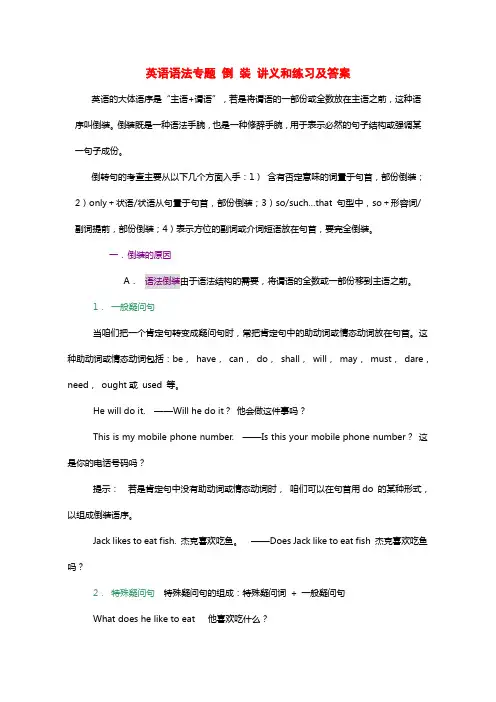
英语语法专题倒装讲义和练习及答案英语的大体语序是“主语+谓语”,若是将谓语的一部份或全数放在主语之前,这种语序叫倒装。
倒装既是一种语法手腕,也是一种修辞手腕,用于表示必然的句子结构或强调某一句子成份。
倒转句的考查主要从以下几个方面入手:1)含有否定意味的词置于句首,部份倒装;2)only+状语/状语从句置于句首,部份倒装;3)so/such…that句型中,so+形容词/副词提前,部份倒装;4)表示方位的副词或介词短语放在句首,要完全倒装。
一.倒装的原因A.语法倒装由于语法结构的需要,将谓语的全数或一部份移到主语之前。
1.一般疑问句当咱们把一个肯定句转变成疑问句时,常把肯定句中的助动词或情态动词放在句首。
这种助动词或情态动词包括:be,have,can,do,shall,will,may,must,dare,need,ought或used 等。
He will do it. ——Will he do it?他会做这件事吗?This is my mobile phone number. ——Is this your mobile phone number?这是你的电话号码吗?提示:若是肯定句中没有助动词或情态动词时,咱们可以在句首用do 的某种形式,以组成倒装语序。
Jack likes to eat fish. 杰克喜欢吃鱼。
——Does Jack like to eat fish 杰克喜欢吃鱼吗?2.特殊疑问句特殊疑问句的组成:特殊疑问词+ 一般疑问句What does he like to eat 他喜欢吃什么?When will they go to the Great Wall 他们何时去长城?Where did you go last night 昨晚你去哪里了?Who is not coming to dinner tonight 今晚谁不来用饭?3. 反意问句在反意问句中,用一般疑问句的形式,前后两分句的主语,人称要一致。
高中英语倒装句详解及练习(高考高频考点)英语中主语和谓语有两种顺序。
主语在前、谓语在后,称之为自然语序;谓语在前、主语在后称之为倒装语序。
倒装语序又分为全部倒装和部分倒装。
本文主要讲解倒装语序的句子,即倒装句。
全部倒装,就是整个谓语都放在主语之前。
如:•Here are some letters for you. 这有你的几封信。
•In came the new teacher. 新老师进来了。
部分倒装,只是谓语中的一部分进行倒装,比如助动词、情态动词、be动词等置于主语前面,其余部分仍放在主语的后面,如:•At no time will China ever behave like a superpower. 中国在任何时候都不做超级大国。
•Only in this is it possible for us to accomplish the task. 只有这样我们才能完成任务。
1.疑问句多为倒装句。
英语中的疑问句就是一种倒装形式。
比如:•正常语序You are tired. (主语‘you’在动词‘are’之前.)•疑问形式: Are you tired? (动词‘are’ 置于主语‘you’之前. 主语和动词的位置发生了变化,这就是倒装形式。
) ,类似的还有:1.1 一般现在时中的‘be’: am I / are you / is he;do you go / does he go1.2 一般过去式中的‘be’: were you / was she;did we go / did they go1.3 现在进行时: am I going / are you going1.4 过去进行时: was he going / were they going1.5 现在完成时: have we gone / has she gone1.6 现在完成进行时: has she been going / have they been going1.7 过去完成时: had you gone1.8 过去完成进行时: had he been going1.9 一般将来时: will they go1.10 一般将来进行时: will you be going1.11 一般将来完成时: will they have gone1.12 将来完成进行时: will she have been going1.13 情态动词: should I go / would you go… …2.感叹句多为自然语序,但疑问形式的感叹句则为倒装语序。
倒装句一、定义:英语最基本的语序是主语在前,谓语动词在后。
但有时由于句子结构的需要或表示强调,就要采用倒装形式。
Eg:The bus comes here.Here comes the bus.车来了。
二、分类:全倒装:将谓语动词完全移到主语之前称为完全倒装,半倒装:只将助动词或情态动词放到主语之前称为部分倒装。
Eg:Many years ago there lived an old man in the wooden house.很多年前有一位老人住在那间木屋里。
Never have I been late for school this term.这学期,我从来没上学迟到过。
三、全倒装:“五全”=有时表地方经常与be/come/exist/fall/follow/go/remain/seem/stand(表示移动或动态的不及物动词连用)或用表示类似“存在”观念的其他不及物动词如:live, stand, come, lie, flow, enter, rise 和appear等✧㈠、“有”:在“there be”结构里Eg:There is a box on the table.桌子上面有一个盒子。
✧㈡、“时”:表示时间副词,如:now,then,Eg:Now comes your turn.现在轮到你了。
✧㈢、“表”:表语放句子前,“表语+系动词+主语”的结构Eg:Present at the party were Mr. Green and many other guests.格林先生和其他的客人在这个聚会上。
Seated on the ground are a group of young men.一群年轻人坐在了地上。
✧㈣、“地”:地点状语放在句首Eg:In south of the river lies a small factory.小工厂位于河的南方。
From the valley came a cry.山谷传来一阵哭声。
【最新整理,下载后即可编辑】雅思写作现代人的生活方式Modern lifestyles make it hard for many people to lead active and healthy lives.What are the factors contributing to that?What do you suggest the governments and other large companies should do to help them do more exercise?Give reasons for your answer and include any relevant examples from your own knowledge or experience.Write at least 250 words.倒装句全部倒装1,here, there, now, then, thus等副词置于句首, 谓语动词常用be, come, go, lie, run。
1)There goes the bell.2)Then came the chairman.3) Here is your letter.2. 表示运动方向的副词或地点状语置于句首,谓语表示运动的动词。
Out rushed a missile from under the bomber.Ahead sat an old woman.注意:上述全部倒装的句型结构的主语必须是名词,如果主语是人称代词则不能完全倒装。
Here he comes. 他来了。
Away they went. 他们走了。
二部分倒装部分倒装是指将谓语的一部分如助动词或情态倒装至主语之前。
如果句中的谓语没有助动词或情态动词,则需添加助动词do, does或did,并将其置于主语之前。
1. 句首为否定或半否定的词语,如no, not, never, seldom, little, hardly, at no time, in no way, not until…等。
高中英语精讲系列2015年5月23日星期六;王懿坤高中英语倒装句讲解和练习英语的基本语序是“主语+谓语”。
如果将谓语的全部或一部分放在主语之前,这种语序叫做“倒装”。
倒装的原因,一是语法结构的需要(如某些疑问句);一是为了强调。
一、使用全部倒装的情况1.在there be/lie/stand/live/seem/appear/exist/come/go 句型中。
如:There goes the ambulance.救护车来了。
2.表示地点、方向、时间的副词(here, out, in, up, down, back off, away, now, then等)位于句首时。
谓语动词多为表示运动的不及物动词(go, come, leave, move, run, rush, ny, jump等)。
如:Here is a telegram for you.这儿有你一封电报。
Down jumped the man from the horse.那人从马上跳下来。
在上述情况中,主语是代词时,则不用倒装。
如:Here you are.给你。
In he came and the meeting began.他进来,会议就开始了。
3.表示地点的介词短语位于句首时。
如:Between the two buildings stands a tall pine.两座楼之间有棵大松树。
4.直接引语的部分或全部位于句首时,点明说话人的部分主谓语要倒装。
如:"Are you listening to English on the radio?" said Mother.但,引述动词后有间接宾语或状语时,不倒装。
如:5.在某些表示祝愿的句子中。
如:Long live our great country!伟大的祖国万岁!二、使用部分倒装的情况1.only修饰的状语(副词、介词短语或状语从句)位于句首时。
如:Only after three operations was he able to walk without sticks.做过三次手术之后,他才能不用拐杖行走。
倒装句讲解与练习一、什么是倒装句?英语的根本句型是:主语 + 谓语。
如果将主语与谓语调换, 则称为倒装句。
倒装句分为:完全倒装句和半倒装句。
二、倒装句的用法〔一〕完全倒装: 主语与谓语交换位置不需任何助动词, 叫全倒装。
全倒装有以下二种情况:1、当here, there, out, in, up, down等副词放在句首时, 句子需全倒装:There goes the bell! 铃响了!There lived an old man.Here comes the bus.注意:①在这种情况下倒装仅限于不及物动词或be动词, 像go, come, mush等。
②主语如果是代词时不需倒装如Away he went. 他走远了。
2、表示地点方位的词或短语放在句首时, 句子需全倒装.。
如:In front of the house stopped a police car.Nearby were two canoes in which they had come to the island.Under the tree sat a boy.〔二〕半倒装: 主语与谓语的助动词交换位置称半倒装, 有以下数种情况:1.表示否认意义的词如 little, never, not, no, hardly, rarely, seldom等放在句首时, 句子用半倒装, 例如:Never shall I forget you.At no time was the man aware of what was happening.Little did I understand what he said to me at that time.2、几对并列连词如not only…but also, hardly… when, no sooner…than等连接两个并列句, 连词在句首时, 前句半倒装, 后句不倒装。
例如:Not only was everything he had taker away from him, but also his German citizenship was taken away.No soone r had I got to the bus stop than the bus started.注意:①not only…but also连接两个并列主语时不需倒装, 如:Not only you but also I like playing chess.②neither…nor在句首时, 前后两句都需倒装, 如:Neither do I have a sister nor does my husband.3、only放在句首强调状语时, 主句用半倒装。
倒装句的用法英语倒装句分为两种:1、整个谓语在前的句子,叫完全倒装。
Here comes the car.2、部分谓语(情态动词、助动词、连系动词)在前,谓语的主体部分仍在主语之后的句子,叫部分倒装句。
Only the n did he realize that he was wrong.必须弄清的两点:①若有主从句,哪句倒装。
②部分倒装还是完全倒装。
一、表示方位和时间的副词位于句首时(now ,the n here ,there,out ,i n ,up,dow n ,away ,back, off,on ),句子全部倒装。
注:主语是代词时,不倒装。
(如5, 6)1. Here comes the bus .2. There goes the bell .3. Away went the stude nts .4. Now comes the cha nee .Out rushed the childre n. he rushed.There comes the bus. he comes.注意:1.不能用进行时; 2.主语为人称代词时不倒装。
二、以介词短语表示的状语,提前位于句首时,全部倒装。
1.ln a lecture hall of a uni versity in En gla nd sits a professor .2.ln front of our school sta nds a tower .3. By either side of the river grow a lot of apple trees .4. At the top of the mountain sta nds a temple .5. Among the goods are Christmas trees,flowers and toys.三、表语位于句首时,倒装结构为“表语+连系动词+主语”A:形容词+连系动词+主语例I.Present at the meeting were Professor White,Professor Smith and many other guests.例2.过去分词+连系动词+主语Gone are the days whe n they could do what they liked to the Chin ese people.四、将so\neither \nor放在开头,表示“…也(不)…”的意思时,部分倒装注:表示“确实是这样”时,不倒装1. He went to the film last night.So did I .2. You must finish your work ,so must I .3.She is in terested in the story ,so am I .4. He didn ' t turn up .Neither did his brother .5. His mother told him not to go to the film .So he did.五、在if条件句中,通常可以省略if ,而将从句倒装条件:在if条件句,必须含有系动词were, 助动词had 和情态动词shouldI. Were he youn ger(=lf he were youn ger ),he would lear n skati ng .2.Should they forget (=If they should forget ) to bring a map with them ,they would get lost in the woods .3. Had they realized (=If they had realized ) how important the task was ,they wouldn ' t have refused to accept .4. Were I you ,I would help her .六、否定词或半否定词(never .little ,seldom ,not ,nowhere ,scarely ,few ,by no means ,at no time ) 位于句首 , 应部分倒装1. Never have I been there .2. Little did I know about it .3.Seldom did she come late to school .4.Not a single mistake did he make .5. By no means should you buy that kind of car .七、 以 notun til ,no sooner …tha n , hardly…whe n ,not only …but also 所弓丨导的状语放 在句首时 ,需要部分倒装 1. Not until 10 'clock will the library open .2. No sooner had I gone out than he came to see me .3. Hardly had the train arrived when I ran to meet my friend.4. Not only does she speak English but also she follows the British way of life .八、 only 及其修饰的状语位于句首时,后面的句子部分倒装。
Grammar of the Inversion (Module 5 Unit 4)倒装句英语最基本的语序是主语在前,谓语动词在后。
但有时由于句子结构的需要或表示强调,就要采用倒装形式。
倒装分两种情况: 1)将谓语动词完全移到主语之前称为完全倒装,2)只将助动词或情态动词放到主语之前称为部分倒装。
并且强调性倒装和以so,neither,nor开头的句子是高考例题的热点。
一、倒装句的意义1. 用倒装构成疑问句,适应一定的语法结构的需要。
e.g. May I come in?Was the People's Liberation Army founded in 1927?2. 为了强调某一部分,而把这部分放到句首,构成倒装。
e.g. Never have I been late for school this term.So early did he come to school that no other students came.二、倒装的用法完全倒装1. 在“there be”结构里,there是引导词,主语在be后。
在“there + be”结构中的谓语动词有时不用be , 而用表示类似“存在”观念的其他不及物动词。
如:live, stand, come, lie, flow, enter, rise 和appear等。
e.g. There is a box on the table.There came shouts for help from the river.There lies a large wheat field in front of the house.Many years ago there lived an old man in the wooden house.2. 为了表达生动,有时把表地点、方位的副词,如here, there, now , then, , thus , up,down,out,off, over, away,in等放在句首,同时把谓语动词放在主语之前, 在here,there等副词开头的某些句子里(要用一般现在时态)。
若主语为人称代词,主语和谓语动词的位置不变,只将副词放在句首。
(完全倒装)。
e.g. There goes the bell.Here is an apple for you.There she comes.(人称代词倒装)e.g. Away hurried the boy.Out rushed the girl.Away she went with tears in her eyes.Ex:Out ____, with a stick in his hand. A. did he rush B. rushed he C. he rushed D. he did rushEx:There ________. And here ________.A. goes the phone; she comesB. is the phone going; is sheC. does the phone go; does she comeD. the phone goes; come she3. 为了保持句子的平衡或为了强调表语和状语,或使上下文紧密衔接,常把表示地点的介词短语(如on the wall, under the tree, in front of the house, in the middle of the room等)放在句首用时, ,要用完全倒装,该结构不需加助动词。
构成: 1) 表(介短)+系+主; 2) 状(介短)+谓动+主. 如: On the top of the hill stands a pine tree.In front of the classroom is a playground.East of the town lies a beautiful lake.In a lecture hall of a university in England sits a professor.Outside the doctor’s clinic were twenty patients.Ex:Under a big tree ________, half asleep.A. did sat a fat manB. a fat man satC. did a fat man satD. sat a fat man4.直接引语的全部或一部分放在句首时,主句中的主谓也常直接倒装。
(完全倒装)e.g. "Very well," said the French student."Bring me two eggs and a cup of tea,please." he said.()5. “表语(代词such) + be + 主语"结构。
如:Such was the story he told me.Such were her words.Such was the result.部分倒装1. 在疑问句中。
e.g. Is she singing in the classroom?What does your mother do?2. 重复倒装句型,用在以so,nor,neither开头,表示谓语所述的情况也适用于另一个人或一事物的肯定或否定句中。
so用于肯定句,表示“也一样”“也这样”;nor,neither用于否定句,表示“同样也不,也不这样”。
e.g. I am watching TV. So is she.My parents didn't watch TV last night. Neither (Nor)did I.She is busy doing her homework. So is her brother.You passed the exam. So did I.He doesn’t like shopping. Neither do i.He can’t speak any foreign language. Nor can his father.注意: 表示两人的同样一个情况时,只能表示一件事,即上、下句所使用的动词、时态要一致。
否则要用so it is with…His uncle is a worker and has been working in the factory for more than ten years. So it is with his aunt.Ex:1)I don't know how to swim, ____.A. and my sister doesn't neitherB. nor my sister canC. nor does my sisterD. and my sister does either2)She's passed the test. ____. A. So am I B. So have I C. So I have D. Also I have3)——Do you know Tom bought a new car?——I don't know, ___.A. nor don't I careB. nor do I careC. I don't care neitherD. I don't care also注意:当so引出的句子用以对上文内容加以证实或肯定时,不可用倒装结构。
意为\"的确如此\"。
例如:Tom asked me to go to play football and so I did. 汤姆邀我去踢球,我去了。
---It\'s raining hard. ---So it is. 雨下得真大。
是呀。
3. 在以hardly(scarcely), never, not, little, few,seldom, nowhere,no,no- 等否定或半否定意义的副词、连词放在句首时要用倒装句,采用部分倒装。
如不放在句首就不要倒装。
e.g. Little did he say at the meeting.Never shall I forget the day when I joined the Army.Not once did we visit the city of our own.Seldom in all my life have I met such a determined person.Never have I seen such a performance. 从未见过如此糟糕的表演。
Nowhere will you find the answer to this question. 无论如何你不会找到这个问题的答案的。
Never have I seen such a performance.Ex.---Why can\'t I smoke here?-----At no time___ in the meeting-roomA. is smoking permittedB.smoking is permittedC. smoking is it permittedD.does smoking permit比较:I shall never forget the day when I joined the Army.Ex:2) —Have you ever seen anything like that before? —No, ________ anything like that before.A. I never have seenB. never I have seenC. never have I seenD. I have seen4. 用于以only所修饰的副词、介词短语或状语从句的句子中。
e.g. Only when the war was over in 1918 was he able to get happily back to wrk.Only in this way can we learn English well.注意:如果only后的词组不是状语,不需倒装。
e.g. Only Wang Lili knows this. onlyOnly a few young men went to the theatre. (修饰主语时则不用倒装)Ex:1)Only in this way ___ make progress in your English. A. you B. can you C. you be able toD. will you able to2) Only when the meeting was over___ go back to meet his friend. A. he could B. he was able to C. was he able to D. was able to he3)Only after liberation___ to be treated as human beings.A.did they beginB. they had begunC.they did beginD. had they begun5. 在虚拟结构中,条件从句的谓语含有were,had 和should这三个词是,可省去if,将这些词移至主语之前。